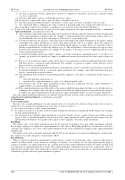Page 508 - SAIT Compendium 2016 Volume2
P. 508
IN 55 (2)
(i)
Income Tax acT: InTeRPReTaTIon noTes IN 55 (2)
any share or part thereof in the equity share capital of a company or a member’s interest in a company, which is a close corporation;
any non-equity share, such as a redeemable preference share;
an option to acquire such a share, part of a share or member’s interest;
(ii)
(iii)
(iv)
(v)
share or member’s interest, for example, a contingent or vested interest in a trust that holds shares.
any other nancial instrument that is convertible to a share, part of a share or member’s interest; and
any contractual right or obligation the value of which is determined directly or indirectly with reference to a
(b) If any of the following restrictions are placed on an equity instrument, the equity instrument will be a ‘restricted equity instrument’, as de ned in section 8C:
(i) Any restriction (other than restrictions imposed by legislation) that prevents the taxpayer from freely disposing of the equity instrument at market value, for example, a requirement that the taxpayer must retain a share for a speci ed number of years or may only dispose of the share to a speci ed person.
(ii) A restriction whereby the taxpayer could either forfeit ownership of the equity instrument or the right to acquire ownership of the equity instrument, at a price other than at market value, for example, where the taxpayer is required to remain in employment for a period, failing which options to acquire shares are forfeited or shares already acquired must be resold to the employer at cost. This will include a restriction where the taxpayer may be subjected to nancial penalties, for example, by the grantor of the shares, for not complying with the terms of the acquisition agreement.
(iii) A restriction granting any person a right to impose one of the restrictions contemplated in (i) or (ii) above, for example, an option by the employer to impose an additional retention period before the shares may be disposed of.
(iv) In the case of an option to acquire a share, if the share to be acquired is a restricted equity instrument the option will then also be a restricted equity instrument. For example, an option to acquire a share that may not be disposed of for a speci ed period.
(v) In the case of any nancial instrument which is convertible into a share or member’s interest that is restricted, the nancial instrument will be a restricted equity instrument. For example, convertible debentures that may only be converted into restricted shares.
(vi) Any instrument that is linked to an undertaking by the employer, at the time of acquisition by the taxpayer, to either—
• cancel the purchase transaction; or
• repurchase the equity instrument at a price exceeding its market value,
if the market value of the equity instrument declines after that acquisition, then the equity instrument so acquired will be a restricted equity instrument.
(vii) If the equity instrument is not deliverable to the taxpayer until the happening of a future event, whether xed or contingent. For example, where the share certi cate is held by the employer until a loan granted to the taxpayer to acquire the equity instrument has been repaid, the equity instrument will be a restricted equity instrument.
Any other equity instrument which does not fall into restricted status in terms of the categories mentioned above is an ‘unrestricted equity instrument’, as de ned in section 8C.
4.3 De nitions
4.3.1 Consideration
In respect of an equity instrument it is any amount given or to be given by (otherwise than in the form of services rendered or to be rendered or anything done, to be done or not to be done)—
(a) the taxpayer in respect of that equity instrument;
(b) the taxpayer in respect of another restricted equity instrument which has been disposal by the taxpayer in exchange
for that equity instrument; or
(c) any other person in acquiring equity instrument at an arm’s length or from a connected person in relation to that
taxpayer. The actual amount paid by that person for the equity instrument will be ignored and is replaced by the
amount which would have been paid by the taxpayer, who originally owned the equity instrument.
Excluding
The market value of an equity instrument given by the taxpayer in exchange for a new equity instrument acquired. For example, employee A acquired an equity instrument to the value of R100 and paid R50 as consideration on the date of grant. Later employee A receives a new equity instrument to the value of R200 in exchange for the equity instrument already held.
The market value of the old equity instrument (R100) will not be taken into account in determining the consideration. The employee has still only paid a consideration of R50.
Provided that:
Where a taxpayer acquired any marketable security (that is, security, stock, debenture, share, option or other interest capable of being sold in a share-market or exchange or otherwise) in exchange for any other right and that right so acquired constitutes an equity instrument, the consideration for that equity instrument will be the initial amount paid in acquisition of original marketable security. The equity instrument acquired is deemed to be acquired by virtue of employment, and the value, if the marketable security is disposed of, may not be taken into account in determining the consideration paid for the new equity instrument acquired.
500 saIT comPendIum oF Tax LegIsLaTIon VoLume 2


